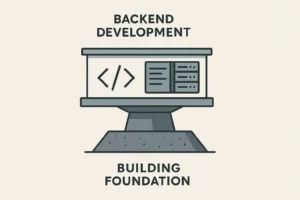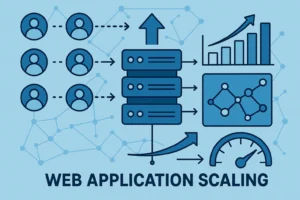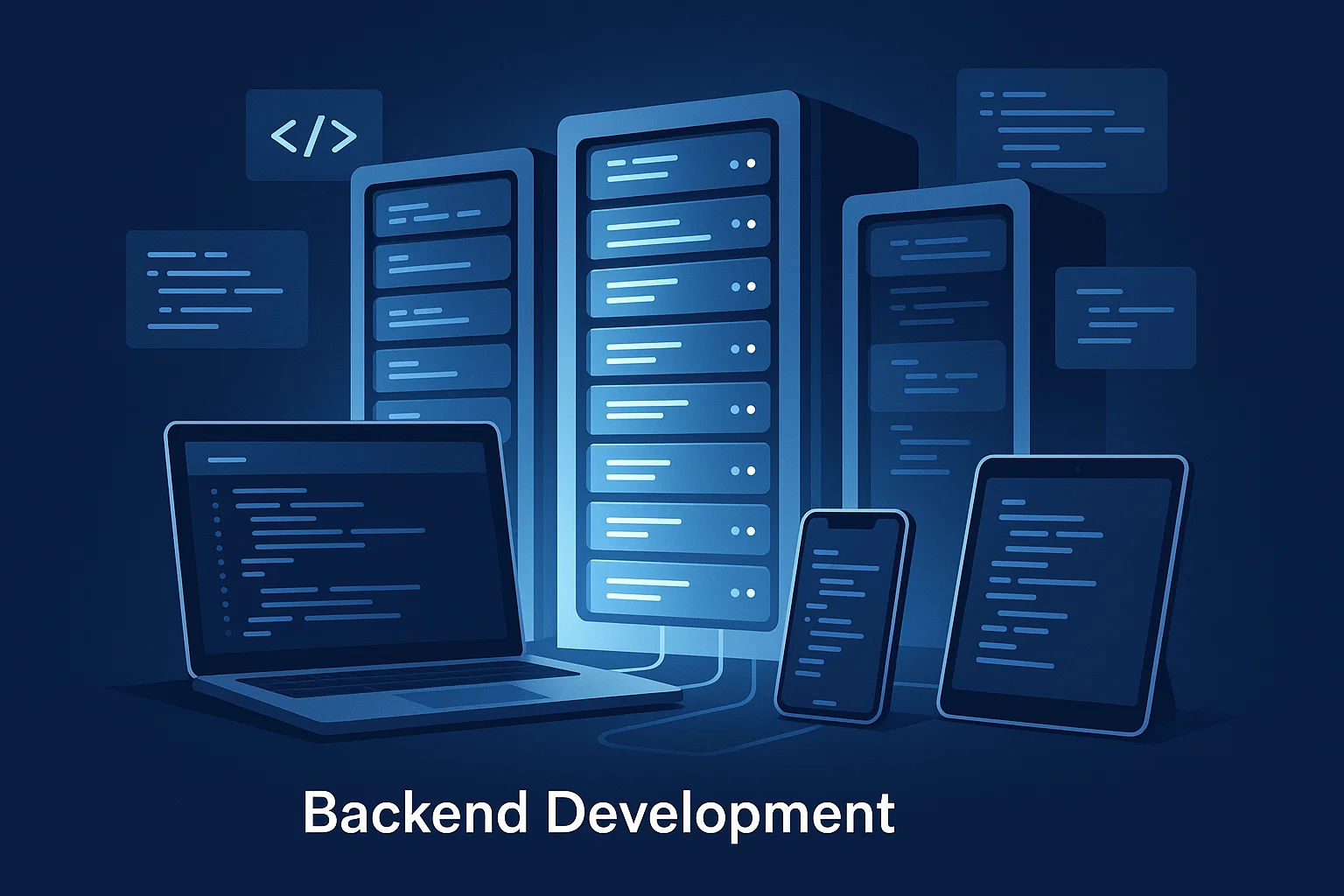“Good engineering is invisible to the user. Things just work.”
Have you ever seen an app that looks great on the surface but slows down or even crashes the moment traffic spikes? From the outside, everything seems fine, but under the hood, the system struggles. That’s exactly where backend development comes in. The frontend is what users see, while the backend powers everything. This is why understanding the importance of backend development is crucial for every product owner, marketer, and founder.
In this article, we’ll explore why backend development is important, its role in scalable web apps, the technologies behind it, best practices, and how it directly supports business growth. Along the way, I’ll share real-world style case notes and simple examples to make it clear.
What is Backend Development?
The backend is the layer that manages app logic, data, security, and server interactions. While the frontend displays buttons, forms, and pages, the backend ensures that:
- User actions are processed with the right logic.
- Data is correctly stored, fetched, and updated in the database.
- Authentication, permissions, and security rules are applied.
- External services like payments, emails, and notifications integrate smoothly.
Simple example: A user presses “Sign Up.” The frontend sends the form. The backend validates inputs, hashes the password, saves the record, triggers an email, and creates a session. All of this happens in milliseconds.

Why Backend Development is Important
This section highlights the core aspects every scalable app needs.
- Stability and Performance: Slow queries, blocking operations, or poorly designed database tables can drag an app down. A strong backend delivers predictable response times, handles spikes, and manages errors gracefully.
- Security and Authentication: Password hashing, token rotation, secure sessions, rate limiting, input sanitization, and role-based permissions – these are all backend responsibilities. A data breach is not just a technical failure; it’s a trust issue.
- API Integration: Modern apps interact with dozens of APIs for payments, messaging, analytics, and more. The backend builds reliable adapters, sets retries and timeouts, and provides fallbacks when failures occur.
- Real-Time Data Management: Chat apps, live dashboards, order tracking, and stock tickers all rely on real-time event handling via WebSockets, event streams, or pub/sub systems – orchestrated by the backend.
Benefits of Backend Development for Scalable Apps
From a business perspective, these are the real backend benefits you’ll notice as your app grows.
Handling Growth from 100 to 1,000,000 Users
Scalability isn’t just “adding more servers.” It requires smart architecture, horizontal scaling, queues, stateless services, and efficient data models to ensure smooth growth.
Database Efficiency
Indexes, query optimization, caching layers, and read replicas reduce latency and balance load. This allows you to ship new features confidently without risking downtime.
Cloud and Server Optimization
Autoscaling groups, serverless functions, and container orchestration provide on-demand capacity. The backend, paired with infrastructure, balances performance and cost.
Future-Ready Architecture
Modular code, clear boundaries, and versioned APIs let you add new features without breaking the system. Technology will evolve, but a flexible backend ensures you can adapt.

Common Backend Technologies Used Today
Not every problem can be solved with the same stack. Choices depend on the use case.
Languages & Frameworks
- Node.js with Express or NestJS (event-driven, tight fit with JS ecosystem).
- Python with Django or FastAPI (clean, rapid development, strong ecosystem).
- PHP with Laravel (productivity and built-in features).
- Java with Spring Boot (enterprise-grade performance).
- Ruby on Rails (convention over configuration, fast iteration).
Databases
- Relational (SQL): PostgreSQL, MySQL (transactions, consistency).
- NoSQL: MongoDB, DynamoDB, Redis (flexibility, caching, event data).
- Search: Elasticsearch, OpenSearch (full-text, analytics).
Messaging & Real-Time Tools
- Kafka, RabbitMQ, SQS, Redis Streams.
- WebSockets, Socket.IO, Server-Sent Events.
Infrastructure & Cloud
- AWS, GCP, Azure.
- Docker, Kubernetes, serverless platforms (Lambda, Cloud Functions).
The right choice depends on business goals, team skills, and scaling needs.
Best Practices for Strong Backend Development
These practices consistently save projects from disaster:
- Clean Architecture – Layered or hexagonal patterns, domain-driven design, and clear module boundaries make code testable and easy to refactor.
- Load Balancing – Distribute traffic across multiple instances, with health checks and zero-downtime deployments.
- Caching & CDN – Cache hot data with Redis, and use CDNs for static assets and APIs to cut latency and costs.
- Observability – Centralized logging, metrics, tracing, and dashboards with alerts help spot issues using data, not guesswork.
- Security Hygiene – Secrets management, dependency updates, audit logs, WAFs, TLS everywhere. Security should be standard practice, not optional.
- Automated Testing & CI/CD – Unit, integration, contract, and load tests, plus CI/CD pipelines for safe, frequent releases.
Case Studies & Examples
Case 1: Flash Sale, Crashed Checkout
A fashion e-commerce brand launched a festive campaign. The frontend was top-class, creatives went viral. But as soon as traffic spiked, checkout APIs failed.
Cause: A single database node, no read replicas, synchronous calls, and no payment queueing.
Fix: Payment workflow was made asynchronous, Redis queues added, database scaled with replicas, and a caching layer introduced. Next campaign, the system stayed stable.
Case 2: SaaS Dashboard, Smooth Scaling
An analytics SaaS chose an event-driven backend from day one. Events were queued, processed by workers, stored in a time-series database, and dashboards served via pre-aggregations. As traffic grew, they simply increased the number of workers.
Result: Predictable costs, fast dashboards, and happy customers.
How Backend Supports Business Growth
Technology is valuable only when it improves business metrics.
- Faster Response Times → Better UX: Low latency directly boosts conversions. Fast searches, responsive carts, and snappy dashboards keep users engaged.
- Handles High Traffic During Campaigns: Product launches, sales, influencer shoutouts – a strong backend absorbs peaks. Downtime is the ultimate revenue killer.
- Reduces Downtime, Builds Trust: Consistent uptime grows brand credibility. Fewer support tickets mean teams can focus on innovation, not firefighting.
Connecting Backend with Frontend and UX
Separating backend from design is a bad habit. Both are parts of the same product.
- A smooth search experience relies on backend indexing and ranking.
- A beautiful checkout screen only works if backend payment flows and retries are reliable.
- Personalization in UI only shines if the backend provides clean data and fast recommendations.
For more on this perspective, check out our earlier blogs:
A Practical Blueprint for Scalability
Whether starting fresh or refactoring, here’s a starter blueprint:
- Define SLAs (latency, uptime, error budgets).
- Choose the right datastore for patterns (Postgres for OLTP, NoSQL for logs).
- Use queues for async tasks (emails, payments, notifications).
- Cache hot reads (Redis) with sensible TTLs.
- Keep services stateless for easy scaling.
- Add health checks, metrics, and tracing from day one.
- Automate deploys with CI/CD and small releases.
- Run load tests before campaigns.
- Plan for failure (circuit breakers, retries, graceful degradation).
This approach lets you ship features quickly while handling scale.
FAQs Founders Often Ask
Q: Should we start with microservices?
A: Not necessary. A well-structured monolith is faster to begin with. Extract services later as complexity grows.
Q: SQL or NoSQL?
A: Depends on workload. SQL for strong consistency and relational data. NoSQL for flexible schemas, events, or massive writes. Many teams use a mix.
Q: Serverless or containers?
A: Serverless is great for burst-heavy, event-driven workloads. Containers/VMs work better for long-running, predictable services.
Conclusion
If you’re asking why backend development is important, the answer is simple: it makes apps reliable, secure, fast, and scalable. It routes data correctly, absorbs traffic spikes, and ensures features behave predictably.
In the short term, visuals may grab attention. But in the long run, backend is the foundation – without it, growth becomes impossible.
When you take the importance of backend development seriously, you gain better performance, less downtime, faster iteration, and happier users. Together, these translate into higher revenue, stronger retention, and greater brand trust.
Keep your frontend beautiful, of course. But make sure your backend is strong – because that’s the heartbeat of your scalable web app.
